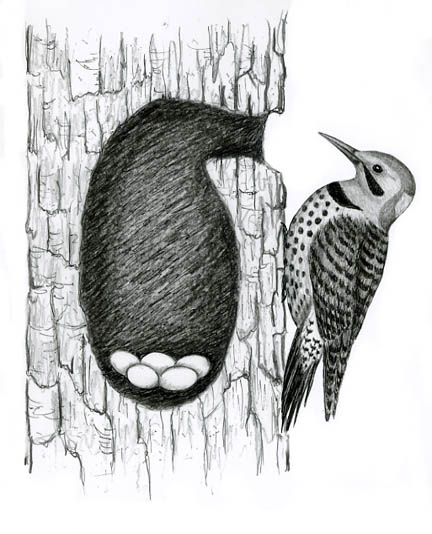
Dear Bird Folks,
My boyfriend has a large dead tree in his yard that he wanted to cut down this spring. Remembering a column that you wrote saying that dead trees are important for birds, I talked him into letting the tree stand. Well, I’m glad we listened to your advice because a few weeks ago, a pair of flickers arrived and began digging out a nest hole. Now it seems that they are sitting on eggs. How long will it be before the eggs hatch and we start seeing baby flickers? -Linda, Eastham, MA
Good job, Linda,
There are several things I really like about your question. First of all, you saved a dead tree. That means someone actually did something that I suggested. What is even more amazing, the birds used the tree, which means my advice worked. Who da thunk it? Also, it’s nice to get a question about woodpeckers that isn’t about their headaches. For the past few months, everywhere I go, for some reason the only thing people want to know about is the woodpeckers and their lack of head pain. If it keeps up I’ll be the one looking for the aspirin.
Of all the woodpeckers, the Northern Flicker (which is a real woodpecker, so don’t let their freaky name fool you) loves dead, rotting trees the most. Typically, woodpeckers have a chisel-shaped bill. The shape of their bill is perfect for hacking into trees of all kinds. But a flicker’s bill is more pointed than the others. They use their pointy bill to probe for their food and do less hacking than other woodpeckers do. Much of their probing takes place on the ground where they hunt for ants. When flickers discover an anthill, they will sometimes blast it apart and quickly snap up the scurrying and very annoyed ants. Other times they leave the colony intact and instead use their long bill and tongue to slurp up ants hiding underground. A flicker has enlarged saliva glands that produce super sticky spit which easily adheres to any ants the come within reach. In addition to the sticky spit the flicker has a wicked long tongue that extends two inches past the tip of the bill. At a party, a flicker could easily impress the crowd by sticking out its tongue and touching its nose, if only it had a nose.
Now, I don’t know how things are between you and your boyfriend, Linda, but if it doesn’t work out, you should consider hooking up with a flicker. Male flickers (which can be distinguished from the females by a black mark or “mustache” near the bill) make excellent mates. Unlike many old school birds, where the females do most of the domestic chores, the male flicker is totally progressive and forward-thinking. He does more than his share of digging out the nesting cavity. Sure, digging out a tree may be no big deal for a guy, but after the eggs have been laid, he is happy to take his turn sitting on and incubating them and he doesn’t care who knows about it. When the kids have hatched, the male once again helps out. He, along with the female, arrives every ten minutes and feeds the babies by regurgitating a fresh batch of ants. Regurgitate indeed. That is the first thing I would do if I swallowed a mouthful of ants.
The young of many common songbirds, jays, cardinals, finches, robins, catbirds, etc., grow amazingly fast. A woven nest, clinging to the branch of a tree, is very susceptible to predation and bad weather. Baby birds don’t have the luxury of growing up slowly. Many backyard birds are off and flying in a mere two weeks after crawling out of the egg. Young flickers, on the other hand, safe and sound in their rotten tree, are in no such hurry to face the outside world. After eleven days of incubation, it’s another twenty-six days of growing before the kids finally get big and bored enough to finally move out.
The Northern Flicker is wide spread throughout the United States, although the western birds have red under their wings and the male’s mustache is red instead of black. It is thought that those red-mustached birds are of Irish descent. South America also has several different species of flickers, and the island of Cuba has its own endemic flicker called the “Fernandina’s Flicker.” Cuba’s flicker is rather similar to ours, only instead of a mustache the male birds have a full beard and occasionally smoke cigars.
I am very glad you saved that dead tree, Linda. Not only are the flickers nesting in it this year, but they probably will return next year too. Once they find a tree that is soft enough for them to dig out, they often return to it year after year. So tell that boyfriend of yours to leave the tree alone or you might dump him for a male flicker. Remember, flickers make excellent mates. They’ll hollow out a nice tree cavity for you and bring you all the regurgitated ants you want. What more could you ask for?